
10 Days Central Tibet Best Tour with Everest Base Camp

Tour Overview
This 10 days Central Tibet Best Tour with Everest Base Camp deals with the essence of Tibetan landscapes and ethic folklore, including most of the major sights in Tibet....
Code of Tour: YCT0000003523
Length of Travel: 10 Day
Destinations of Tour: Lhasa-Tsedang - Yamgdrok Lake - Gyantse - Shigatse - Sakya - EBC - Shigatse - Lhasa
Departure City: Lhasa
Price of Tour: Request
Type of Tour:
Features of Tour: Nature Culture Minority Landscape
This 10 days Central Tibet Best Tour with Everest Base Camp deals with the essence of Tibetan landscapes and ethic folklore, including most of the major sights in Tibet. Lhasa is the main political and economic center of Tibet, while Tsetang serves as the cradle of Tibetan civilization. Gyantse is the historic trade hub and Shigatse is the seat of the Panchen Lama and the monastery houses the biggest gilded statue of Maitreya (Buddha of the future) in world. Of course, the most important part is the chance to gaze on the magnificent north face of the world’s tallest peak, Mt Everest.
Highlights:
- Visit the craddle of Tibetan civilization-Tsedang.
- Enjoy the starry sky and stunning sunrise of Mt. Everest.
- Experience Tibetan Buddhism in significant monasteries in Lhasa and Shigatse.
- Meet the tranquil lakes, white snow mounatians, shimmering rivers and rare animals along your way.
Brief Itinerary
- Day 1: Lhasa-Tsedang
- Day 2: Tsedang
- Day 3: Tsedang-Gyantse
- Day 4: Gyantse-Sakya
- Day 5: Sakya-EBC
- Day 6: EBC-Shigatse
- Day 7: Shigatse-Lhasa
- Day 8: Lhasa
- Day 9: Lhasa
- Day 10: Lhasa Departure
Google Map
Detailed Itinerary
Day 1 Lhasa-Tsedang
Sightseeing and Activities:Lhasa Arrival
Accommodation:Tsedang
Meals:None
When you arrive at Lhasa Gonggar Airport, your guide will greet you and drive to Tsedang (2 hrs driving). The rest time is for you to take a good rest and get acclimated to the altitude. Stay overnight in Tsedang.
Day 2 Tsedang
Sightseeing and Activities:Yumbu lhakhang, Trandruk , Samye monastery
Accommodation:Tsedang
Meals:Breakfast, Lunch
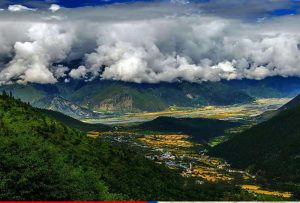
Tsedang is reputed as “the cradle of Tibetan Civilization””. In the morning, tourists will visit Yumbu lhakhang, the first imperial palace built on the rocky hill for the first Tibetan king and you could have nice view the whole valley from there. Then visit one of the oldest temples ,trandruk with a history of 1,300 years, which is the one tourists couldn’t afford to miss and drive to Samye Monastery, the Tibet first Buddhist monastery, built in 8 century and the first monastery completed with the three Buddhist jewels of Buddha, Dharma and Sangha. Stay overnight in Tsedang.
Day 3 Tsetang (3100m)to Gyantse(3950m)
Sightseeing and Activities:Yamdrok lake, Karo Glacier, Gyantse monastery
Accommodation:Gyantse
Meals:Breakfast, Lunch
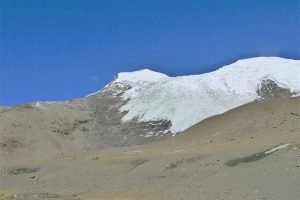
Today, lots of beautiful scenery will be seen on the way to Gyantse. Passing over the Gampala Pass (4790 m),you will have a glimpse of Yamdrok-tso (4400m) .The Lake is surrounded by many snow-capped mountain and in the distance you have spectacular views of Holy Mount Nyenchen Khangsar, (7191m) the highest mountain near Lhasa . We head westward along the lake can see Karo Glacier and drive towards Gyantse. Gyantse was historically Tibet’s third largest city (after Lhasa and Shigatse). Stay overnight in Gyantse.
Day 4 Gyantse(3950m) to Sakya(4300m)
Sightseeing and Activities:Tashi Lhunpo Monastery,Sakya Monastery
Accommodation:Sakya
Meals:Breakfast, Lunch
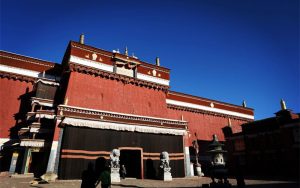
In the Morning, we drive towards Shigatse. In Shigatse, you will visit the famous Tashilhunpo Monastery where you can see the well-preserved largest statue of Jampa (future Buddha) in the world. This monastery is the seat of Tibet’s second highest incarnation, the Panchen Lama. In the afternoon we drive to the Sakya County where tourists can visit the famous Sakya Monastery. It was founded in 1073 and was the principal monastery of the Sakya sect of Tibetan Buddhism. Sakya monastery consists of two parts, northern and southern monastery. The Northern monastery is only visible as a ruin while Southern monastery was built like a fortress, surrounded by a moat. Stay overnight in Sakya.
Day 5 Sakya (4300m) to EBC (5200m)
Sightseeing and Activities:Rongpuk Monastery, Everest base camp
Accommodation:Rongbuk Hostel
Meals:Breakfast, Lunch
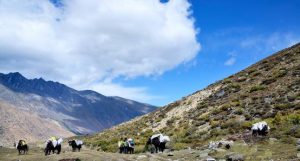
Today we will drive from Sakya to Rongpuk. Pay a visit to Rongbuk Monastery. As road is currently under construction, from Tingri to E.B.C, we have to drive on the rough road, pass the wild grassland, cross the torrent and high mountains. If the weather is clear, you can have a glimpse of 4 mountains which are 8000m high or even higher. Enjoy your remaining time at Everest Base Camp. Stay overnight in Ronguk Guest House or Tent
Day 6 EBC (5200m) to Shigatse(3900m)
Sightseeing and Activities: sunrise of Mt Everest, Rongphu Monastery
Accommodation:Shigatse
Meals:Breakfast, Lunch
In the morning, you can see the sunrise appearing on the top of Mt. Everest, and have a full view the magnificent Mt. Everest standing like a snow-capped pyramid in front of you at Rongpuk, which is the vantage point for watching Mt. Everest. Tourists can also tour Rongphu Monastery which is the highest monastery in the world (5000m) and belongs to Nyingma sect. After that, drive back to Shigatse. Stay overnight in Shigatse.
Day 7 Shigatse(3900m) to Lhasa(3650m)
Sightseeing and Activities:Yarlung Tsangpo River / Bhamaputra River
Accommodation:Lhasa
Meals:Breakfast, Lunch
Today, we will back to Lhasa on the friendship Highway. The whole distance is almost 280km and it takes 6 hours along the Yarlung Tsangpo River / Bhamaputra River (the Longest and largest river in Tibet). Stay overnight in Lhasa
Day 8 Lhasa
Sightseeing and Activities:Potala Palace, Jokhang temple, Barkhor Street
Accommodation:Lhasa
Meals:Breakfast, Lunch
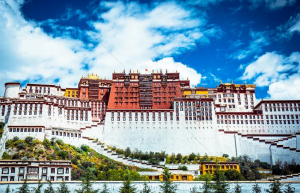
Today’s tour will first bring you to the Potala Palace, the winter palace of the Dalai Lama. It has been used since the 7th Century by the 33rd great king of Tibet. The most valuable collection are the gilded burial stupas of past Dalai Lamas and meditation Cave of the 33rd great king of Tibet.
After you take lunch and then head to Jokhang Temple which was founded by the 33rd great king of Tibet in the 7th century, in order to promote the Buddhist religion. Inside you can see the statue of Buddha Sakyamuni at the age of twelve, perhaps the single most venerated object in Tibet Buddhism.
Around the temple Barkhor Street where you can do kora (circling the Barkhor street) with pilgrims and locals and buy the souvenirs. Stay overnight in Lhasa.
Day 9 Lhasa
Sightseeing and Activities: Drepung Monastery, Carpet factory, Sera Monastery
Accommodation:Lhasa
Meals:Breakfast, Lunch
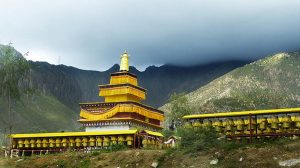
In the morning, you are going to visit Drepung Monastery which was one of the “three greet” Gelug monasteries of Tibet and was founded in 1416 by Jamyang choge, one of the Tsongkhapa’s main disciples. Ganden palace is used as Dalai lama’s palace in the Drepung before moving to the Potala palace.
Afternoon, Sera Monastery—It was one of the “three great” Gelug monasteries of Tibet and was founded in 1419 by Jamchen chojey, one of the Tsongkhapa’s main disciples. The highlight is the Monks debate at around 3 – 5 in the afternoon. Stay overnight in Lhasa.
Day 10 Depart from Lhasa
Sightseeing and Activities:Lhasa Departure
Accommodation:None
Meals:Breakfast
You will be transfered to the airport for your next destination.
Recommended Hotels
| Destination | 5 Star | 4 Star | 3 Star |
| Tsedang | / | Tsedang Hotel | Jinglong Business Hotel |
| Gyantse | / | / | Gyantse Hotel |
| Sakya | / | Brahmaputra Hotel | Sakya Hotel |
| Shigatse | / | Shigatse Manasarovar Hotel | Jiumu Yamei Hotel in Shigatse |
| Lhasa | Luxury St. Regis Lhasa Resort | Lhasa Gang Gyan Hotel | Lhasa Xiongbala Hotel |
Service Included:
-
Tibet travel permit and all other necessary permits to Tibet;
-
All entrance ticket fees for all tourist sites listed in the itinerary;
-
Personal knowledgeable English-speaking Tibetan local tour guide;
-
Personal comfortable, clean and safe vehicle with reliable Tibetan local driver; vehicle ranging from 4WD land cruiser to minibus depending on your group size;
-
All lodging listed in the itinerary; it’s your decision about the accommodation class: luxury 5-star international hotel, comfortable 4-star hotel, economic 3-star hotel or budget hostel, guesthouse or tent. Please tell us your accommodation preference when submitting the enquiry; we will arrange the best-value hotels for you.
-
Domestic flight/train tickets listed in the itinerary;
-
All meals listed in the above itinerary;
-
Tourist accident/casualty insurance;
-
First aid kit;
Service Excluded:
-
International flight to and out of China;
-
Chinese visa (Note: we could help you with the Chinese visa application, like providing the invitation letter, presenting the hotel or domestic flight reservation copies, etc that you may need. )
-
Domestic flight/train not listed in the itinerary. (We can provide you the domestic flight/train ticket booking service at the BEST discount price; please contact us our travel experts for the details.)
-
Meals not specified in the itinerary; usually it costs about USD3-15 per person for one meal in TAR (Tibet Autonomous Region).
-
Tips and gratitude to tour guide and driver;
-
Personal expenses, like laundry, phone call, snacks, soft drinks (please do the best to avoid the alcoholic beverages during your Tibet trip), optional tour activities, etc.
Travel Tips:
- Tibet Permits
There are several permits required to visit Tibet. Tibet Entry Permit, issued by Tibet Tourism Bureau, is the most important one which has to be obtained before your trip because you must have it to take your flight/train to Tibet. To get the permit, you have to book a Tibet tour with us, and send us your passport and Chinese visa about 20 days in advance, and then let us apply for the permit (all Tibet permits can only be applied by travel agency). If you travel to other prefectures like Shigatse, Nyingchi, Shannan, etc, you also have to obtain an Alien Travel Permit. If you travel to Mount Everest, you have to obtain a Border Permit. (Tibet Discovery, with office in Lhasa, has always kept up with the latest news on Tibet Permits. Traveling with us, all your permits are guaranteed as long as you are qualified to the requirements.)
- Available Months to Visit Tibet
Generally speaking, May to early October is the best time to for a Mount Kailash trip. July and August are the peak season and rainy season. It may be too cold to travel in Kailash area from November to March. There is usually heavy snow. The conditions in Namtso Lake and Mount Everest area are quite similar with Kailash. While other places like Lhasa, Gyantse and Shigatse are suitable for travel all year around.
- High Altitude Sickness
The average altitude of Tibet is about 4000 meters above the sea level (Lhasa: 3700m; EBC: 5200m; Namtso: 4718m). You may suffer a bit from High Altitude Sickness in the beginning days of your Tibet trip if you haven’t had rich high plateau travel experience. But don’t worry too much, the high altitude can be acclimatized usually in 2~3 days. Our suggestion is to take a physical examination and get suggestions from your doctor, and also bring some medicines to prevent from High Altitude Sickness before your trip. While in Tibet, you should keep warm all the time, avoid strenuous activities, drink more water and eat more vegetables and carbohydrates. You’d better not take showers during the first two days after your arrival at Tibet. If you don’t feel well, get help from your tour guide or go to the hospital without any delay.
- How to Go to Tibet
Basically you have two options – flight and train. Currently, you can take a flight to Lhasa from Beijing(4.5hrs), Xian(3.7hrs), Chengdu(2.5hrs), Chongqing(3hrs), Kuming(3hrs), etc. Among all these cities, Chengdu and Xian have more frequent flights to Lhasa. Kathmandu also has several flights to Lhasa each week.
If you a train travel, you can take a train to from Beijing(40.5hrs), Xian(32hrs), Chengdu(43hrs), Shanghai(47hrs), Chongqing(42hrs), Lanzhou(25hrs), Xining(22hrs), Guangzhou(54hrs).
- Packing and Wearing Ideas
Firstly you can’t forget your passport and Chinese Visa. A large backpack and a smaller one are recommended (the smaller one can be used for daily activities). Also bring the necessary medicine you need. Other stuffs like sunglasses, snow glasses, hats, lip balm, sun block are recommended. As for wearing, you are suggested to dress in layers (both thin and thick jackets). Down jacket is necessary in Spring and Autumn. A pair of durable and comfortable shoes is necessary.

















